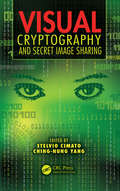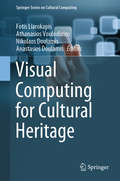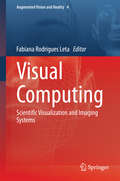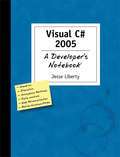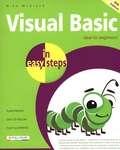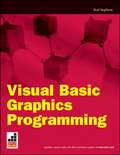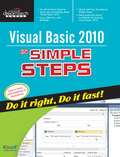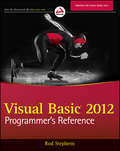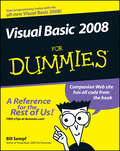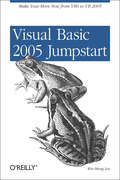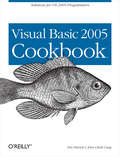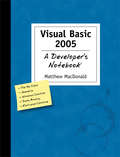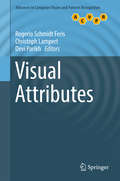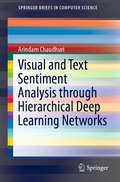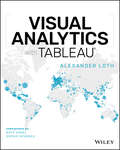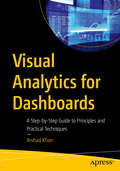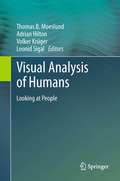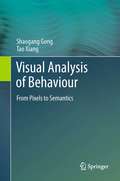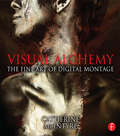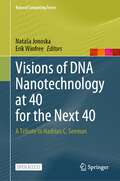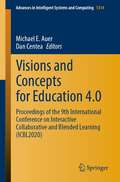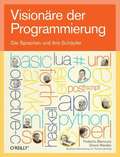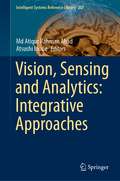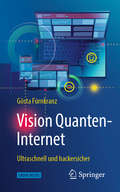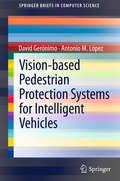- Table View
- List View
Visual Cryptography and Secret Image Sharing
by Stelvio Cimato Ching-Nung YangWith rapid progress in Internet and digital imaging technology, there are more and more ways to easily create, publish, and distribute images. Considered the first book to focus on the relationship between digital imaging and privacy protection, Visual Cryptography and Secret Image Sharing is a complete introduction to novel security methods and sharing-control mechanisms used to protect against unauthorized data access and secure dissemination of sensitive information. Image data protection and image-based authentication techniques offer efficient solutions for controlling how private data and images are made available only to select people. Essential to the design of systems used to manage images that contain sensitive data—such as medical records, financial transactions, and electronic voting systems—the methods presented in this book are useful to counter traditional encryption techniques, which do not scale well and are less efficient when applied directly to image files. An exploration of the most prominent topics in digital imaging security, this book discusses: Potential for sharing multiple secrets, Visual cryptography schemes—based either on the probabilistic reconstruction of the secret image, or on different logical operations for combining shared images, Inclusion of pictures in the distributed shares, Contrast enhancement techniques, Color-image visual cryptography, Cheating prevention, Alignment problems for image shares, Steganography and authentication In the continually evolving world of secure image sharing, a growing number of people are becoming involved as new applications and business models are being developed all the time. This contributed volume gives academicians, researchers, and professionals the insight of well-known experts on key concepts, issues, trends, and technologies in this emerging field.
Visual Computing for Cultural Heritage (Springer Series on Cultural Computing)
by Anastasios Doulamis Fotis Liarokapis Athanasios Voulodimos Nikolaos DoulamisThis book provides insights into the state of the art of digital cultural heritage using computer graphics, image processing, computer vision, visualization and reconstruction, virtual and augmented reality and serious games. It aims at covering the emergent approaches for digitization and preservation of Cultural Heritage, both in its tangible and intangible facets. Advancements in Digital Cultural Heritage research have been abundant in recent years covering a wide assortment of topics, ranging from visual data acquisition, pre-processing, classification, analysis and synthesis, 3D modelling and reconstruction, semantics and symbolic representation, metadata description, repository and archiving, to new forms of interactive and personalized presentation, visualization and immersive experience provision via advanced computer graphics, interactive virtual and augmented environments, serious games and digital storytelling. Different aspects pertaining to visual computing with regard to tangible (books, images, paintings, manuscripts, uniforms, maps, artefacts, archaeological sites, monuments) and intangible (e.g. dance and performing arts, folklore, theatrical performances) cultural heritage preservation, documentation, protection and promotion are covered, including rendering and procedural modelling of cultural heritage assets, keyword spotting in old documents, drone mapping and airborne photogrammetry, underwater recording and reconstruction, gamification, visitor engagement, animated storytelling, analysis of choreographic patterns, and many more. The book brings together and targets researchers from the domains of computing, engineering, archaeology and the arts, and aims at underscoring the potential for cross-fertilization and collaboration among these communities.
Visual Computing
by Fabiana Rodrigues LetaThis volume aims to stimulate discussions on research involving the use of data and digital images as an understanding approach for analysis and visualization of phenomena and experiments. The emphasis is put not only on graphically representing data as a way of increasing its visual analysis, but also on the imaging systems which contribute greatly to the comprehension of real cases. Scientific Visualization and Imaging Systems encompass multidisciplinary areas, with applications in many knowledge fields such as Engineering, Medicine, Material Science, Physics, Geology, Geographic Information Systems, among others. This book is a selection of 13 revised and extended research papers presented in the International Conference on Advanced Computational Engineering and Experimenting -ACE-X conferences 2010 (Paris), 2011 (Algarve), 2012 (Istanbul) and 2013 (Madrid). The examples were particularly chosen from materials research, medical applications, general concepts applied in simulations and image analysis and other interesting related problems.
Visual C# 2005: A Developer's Notebook
by Jesse LibertyIn the three years since Microsoft made C# available, there have been lots of tweaks to the language. That's because C# is not only essential for making .NET work, it's a big way for Microsoft to attract millions of Java, C and C++ developers to the platform. And C# has definitely made some inroads. Because of its popularity among developers, the language received standardization from ECMA International, making it possible to port C# applications to other platforms. To bolster its appeal, C# 2.0 has undergone some key changes as part of Visual Studio 2005 that will make development with .NET quicker and easier. That's precisely what Visual C# 2005: A Developer's Notebook allows you to do. There are some great new features in C# and this unique "all lab, no lecture" guide covers them all with 50 hands-on projects. Each project explores a new feature, with emphasis on changes that increase productivity, simplify programming tasks, and add functionality to applications. C#'s component-based design combines the productivity of Microsoft's popular Visual Basic with the raw power of C++ for web-based applications. Many reviewers note a similarity between C# and Java--in fact, a new feature that took the Java development team five years to incorporate into Java is now available in C# 2.0. Called "generics", this feature enables developers to reuse and customize their existing code, so they can dramatically cut down the time it takes to develop new applications. Visual C# 2005: A Developer's Notebook is full of no-nonsense code without the usual page-filling commentary. You'll find suggestions for further experimentation, links to on-line documentation, plus practical notes and warnings. The book also tells developers how to acquire, install and configure Visual Studio 2005. Are you a coder to the core? Learn what C# 2.0 can do for you now.
Visual Basic in Easy Steps: Updated for Visual Basic 2019
by Mike McGrathVisual Basic in easy steps, 6th edition gives you code examples, screenshots, and step-by-step instructions that illustrate each aspect of Visual Basic so you'll be creating your own interactive applications in no time!. <p><p> You need have no previous knowledge of any programming language so it's ideal if you're a newcomer to Windows programming. Each chapter builds your knowledge of Visual Basic. By the end of this book you will have gained a sound understanding of Visual Basic programming and be able to create your own interactive applications. <p><p> Visual Basic in easy steps, 6th edition has an easy-to-follow style that will appeal to anyone who wants to begin Windows programming. It will appeal to programmers who want to quickly learn the latest Visual Basic techniques, and to the student who is studying computing at school or college, and to those seeking a career in Information Technology who needs a thorough understanding of Visual Basic programming.
Visual Basic Graphics Programming
by Rod StephensThis Wrox Blox shows you how to add graphics to Visual Basic 2008 applications by explaining fundamental graphics techniques such as: drawing shapes with different colors and line styles; filling areas with colors, gradients, and patterns; drawing text that is properly aligned, sized, and clipped exactly where you want it; manipulating images and saving results in bitmap, JPEG, and other types of files. Also covered are instructions for how to greatly increase your graphics capabilities using transformations, which allow you to move, stretch, or rotate graphics. They also let you work in coordinate systems that make sense for your application. The author also describes techniques for using the above in printouts, describing the sequence of events that produce a printout and show how to generate and preview printouts, with examples which show how to wrap long chunks of text across multiple pages, if necessary. In addition, you will learn about two powerful new graphic tools that were introduced with . NET Framework 3. 0: WPF graphics and FlowDocuments. XAML graphic commands allow a WPF application to draw and fill the same kinds of shapes that a program can draw by using graphics objects. Finally, a discussion on the FlowDocument object shows you how to define items that should be flowed across multiple pages as space permits. This lets you display text, graphics, controls, and other items that automatically flow across page breaks. FlowDocument viewers make displaying these documents easy for you, and simplifies the user's reading of the documents. This Wrox Blox also contains 35 example programs written in Visual Basic 2008, although most of the code works in previous versions of Visual Basic . NET as well. The most notable exceptions are WPF graphics and FlowDocuments, both of which require WPF provided in . NET Framework 3. 0 and later.
Visual Basic 2010 in Simple Steps
by Kogent Learning Solutions Inc.VISUAL BASIC 2010 IN SIMPLE STEPS is a beginner’s guide that helps you to learn Visual Basic using Visual Studio 2010. This book aims at providing you a strong programming foundation by explaining every concept with an example to support it. Precision, an easy-to-understand style, and practical approach in presentation are some of the features that make the book unique in itself. The text in the book is presented in such a way that it is equally helpful to beginners as well as professionals. The book covers: Introduction to .NET Framework 4.0 and Visual Studio 2010 Fundamentals of Visual Basic 2010 programming language Key concepts related to object-oriented programming Developing Windows Forms applications using common Windows controls Creating menus, toolbars, and dialog boxes Creating graphic-rich desktop applications using WPF Creating workflow-based applications with WF Programming with ADO.NET and LINQ Building service-oriented applications using Web services and WCF Deployment of applications in Visual Basic 2010 Creating applications using AJAX and AJAX Control Toolkit Popular Search
Visual Basic 2008 Programmer's Reference
by Rod StephensProviding programmers and developers of all skill levels with a comprehensive tutorial and reference to Visual Basic (VB) 2008, Microsoft MVP Rod Stephens presents a broad, solid understanding of essential topics on the latest version of VB. He explains the forms, controls, and other objects that VB furnishes for building applications in a modern windows environment. Plus, he examines the powerful development environment that makes VB such a productive language, and he delves into the VB language itself to show you how to use it to perform an array of important development tasks.Note: CD-ROM/DVD and other supplementary materials are not included as part of eBook file.
Visual Basic 2008 For Dummies
by Bill SempfVisual Basic is a favorite programming language, so if you're new to programming, it's a great place to start. Visual Basic 2008 For Dummies is the fun and easy way to begin creating applications right away while you get the hang of using the Visual Studio environment. Soon you'll be building all sorts of useful stuff with VB 2008!This step-by-step guide walks you through a logical series of tasks that build your skills as you get comfortable with .Net terminology, theory, tools, and design principles. You'll learn how to build an application in four different architectural styles, and you'll find out how to make your programs validate input and output, make decisions, and protect themselves from security threats. Discover how to:Install the Visual Studio environmentWrite a VB programUse Web forms, Windows forms, and Web servicesEstablish good programming practicesCreate class librariesWrite secure applicationsDebug your applicationsWork with strings and "if-then" statementsIterate with counted and nested loopsPass arguments and get return valuesAccess data with VB.NETWork with the file system using VBYou'll also find great tips for working with the VB user interface, using VB.NET in C# programming, troubleshooting your VB programs, taking your programming to the next level, and more! Once you get your hands on Visual Basic 2008 For Dummies, you'll be programming like a genius in no time!
Visual Basic 2005 Jumpstart
by Wei-Meng LeeOkay, all you VB6 developers--time's up. As of March 2005, Microsoft no longer supports this version of Visual Basic. And you can't blame them. Three years ago, they introduced the .NET Framework--an elegant, powerful platform--along with the new component-based VB.NET language. But roughly five million of you decided to stick with VB6, mostly to maintain legacy Windows and COM projects. Now, with the upcoming release of VB 2005, Microsoft has several attractive reasons to upgrade that you'll find hard to resist, including the return of some VB6 features. And we have the perfect book to help you make the conversion: Visual Basic 2005 Jumpstart. Now, you can test-drive the beta version of VB 2005 with three hands-on projects that enable you to learn the syntax of this new language quickly. VB 2005 not only lets you convert the bulk of your existing VB6 code, but offers several familiar features, such as compile-and-run debugging, new MyClasses that simplify use of .NET libraries and frameworks, lots of IDE support for Windows, web and mobile GUI development, and data access controls that closely resemble what you use now. The real plus is that you'll be using these features with the .NET platform, which is more secure, less complex than COM, and offers OneClick deployment. Visual Basic 2005 Jumpstart lets you get the feel of this platform for building smart/rich Windows Forms clients, ASP.NET web applications, and web services. Author Wei-Meng Lee, a Microsoft .NET MVP, veteran O'Reilly author and frequent contributor to the O'Reilly Network, has put together three useful test-drive projects, complete with code samples, that let you develop: A personal library Windows application A Web-based shopping cart application A stock enquiry Web Service Our jumpstart guide is the quick, painless way to migrate from VB6 to VB 2005, and the perfect training manual for moving your organization to the more robust, dynamic and secure world of .NET.
Visual Basic 2005 Cookbook: Solutions for VB 2005 Programmers (Cookbooks (O'Reilly))
by Tim Patrick John Clark CraigThis book will help you solve more than 300 of the most common and not-so-common tasks that working Visual Basic 2005 programmers face every day. If you're a seasoned .NET developer, beginning Visual Basic programmer, or a developer seeking a simple and clear migration path from VB6 to Visual Basic 2005, the Visual Basic 2005 Cookbook delivers a practical collection of problem-solving recipes for a broad range of Visual Basic programming tasks. The concise solutions and examples in the Visual Basic 2005 Cookbook range from simple tasks to the more complex, organized by the types of problems you need to solve. Nearly every recipe contains a complete, documented code sample showing you how to solve the specific problem, as well as a discussion of how the underlying technology works and that outlines alternatives, limitations, and other considerations. As with all O'Reilly Cookbooks, each recipe helps you quickly understand a problem, learn how to solve it, and anticipate potential tradeoffs or ramifications. Useful features of the book include: Over 300 recipes written in the familiar O'Reilly Problem-Solution-Discussion format Hundreds of code snippets, examples, and complete solutions available for download VB6 updates to alert VB6 programmers to code-breaking changes in Visual Basic 2005 Recipes that target Visual Basic 2005 features not included in previous releases Code examples covering everyday data manipulation techniques and language fundamentals Advanced projects focusing on multimedia and mathematical transformations using linear algebraic methods Specialized topics covering files and file systems, printing, and databasesIn addition, you'll find chapters on cryptography and compression, graphics, and special programming techniques. Whether you're a beginner or an expert, the Visual Basic 2005 Cookbook is sure to save you time, serving up the code you need, when you need it.
Visual Basic 2005: A Developer's Notebook
by Matthew MacdonaldWhen Microsoft introduced the Visual Basic .NET programming language, as part of its move to the .NET Framework two years ago, many developers willingly made the switch. Millions of others, however, continued to stick with Visual Basic 6. They weren't ready for such a radical change, which included an object-oriented environment similar to Java. They liked the old Visual Basic just fine. In an effort to win over those diehard VB6 developers, the company has included a new version of VB.NET in its upcoming next generation release of the Visual Studio .NET development platform. Visual Basic 2005 comes with innovative language constructs, new compiler features, dramatically enhanced productivity and an improved debugging experience. The language's new version is now available in beta release, and Microsoft is encouraging developers to give it a test drive. Visual Basic 2005: A Developer's Notebook provides the ideal test track. With nearly 50 hands-on projects, this practical introduction to VB 2005 will bring you up to speed on all the new features of this language by allowing you to work with them directly. The book summarizes the changes that VB 2005 brings, and tells you how to acquire, install and configure the beta version of VB 2005 SDK. Each project or experiment explores a different feature, with emphasis on changes that can increase productivity, simplify programming tasks, and help you add new functionality to your applications. This one-of-a-kind book also offers suggestions for further experimentation, links to on-line documentation and other sources of information, and practical notes and warnings from the author. The new Developer's Notebooks series from O'Reilly offers an in-depth first look at important new tools for software developers. Emphasizing example over explanation and practice over theory, they focus on learning by doing you'll get the goods straight from the masters, in an informal and code-intensive style. For those who want to get up speed with VB 2005 right away, this is the perfect all lab, no lecture guide.
Visual Attributes
by Devi Parikh Christoph Lampert Rogerio Schmidt FerisThis unique text/reference provides a detailed overview of the latest advances in machine learning and computer vision related to visual attributes, highlighting how this emerging field intersects with other disciplines, such as computational linguistics and human-machine interaction. Topics and features: presents attribute-based methods for zero-shot classification, learning using privileged information, and methods for multi-task attribute learning; describes the concept of relative attributes, and examines the effectiveness of modeling relative attributes in image search applications; reviews state-of-the-art methods for estimation of human attributes, and describes their use in a range of different applications; discusses attempts to build a vocabulary of visual attributes; explores the connections between visual attributes and natural language; provides contributions from an international selection of world-renowned scientists, covering both theoretical aspects and practical applications.
Visual and Text Sentiment Analysis through Hierarchical Deep Learning Networks (SpringerBriefs in Computer Science)
by Arindam ChaudhuriThis book presents the latest research on hierarchical deep learning for multi-modal sentiment analysis. Further, it analyses sentiments in Twitter blogs from both textual and visual content using hierarchical deep learning networks: hierarchical gated feedback recurrent neural networks (HGFRNNs). Several studies on deep learning have been conducted to date, but most of the current methods focus on either only textual content, or only visual content. In contrast, the proposed sentiment analysis model can be applied to any social blog dataset, making the book highly beneficial for postgraduate students and researchers in deep learning and sentiment analysis. The mathematical abstraction of the sentiment analysis model is presented in a very lucid manner. The complete sentiments are analysed by combining text and visual prediction results. The book’s novelty lies in its development of innovative hierarchical recurrent neural networks for analysing sentiments; stacking of multiple recurrent layers by controlling the signal flow from upper recurrent layers to lower layers through a global gating unit; evaluation of HGFRNNs with different types of recurrent units; and adaptive assignment of HGFRNN layers to different timescales. Considering the need to leverage large-scale social multimedia content for sentiment analysis, both state-of-the-art visual and textual sentiment analysis techniques are used for joint visual-textual sentiment analysis. The proposed method yields promising results from Twitter datasets that include both texts and images, which support the theoretical hypothesis.
Visual Analytics with Tableau
by Alexander LothA four-color journey through a complete Tableau visualization Tableau is a popular data visualization tool that’s easy for individual desktop use as well as enterprise. Used by financial analysts, marketers, statisticians, business and sales leadership, and many other job roles to present data visually for easy understanding, it’s no surprise that Tableau is an essential tool in our data-driven economy. Visual Analytics with Tableau is a complete journey in Tableau visualization for a non-technical business user. You can start from zero, connect your first data, and get right into creating and publishing awesome visualizations and insightful dashboards. • Learn the different types of charts you can create • Use aggregation, calculated fields, and parameters • Create insightful maps • Share interactive dashboards Geared toward beginners looking to get their feet wet with Tableau, this book makes it easy and approachable to get started right away.
Visual Analytics for Dashboards: A Step-by-Step Guide to Principles and Practical Techniques
by Arshad KhanThis book covers the key principles, best practices, and practical techniques for designing and implementing visually compelling dashboards. It explores the various stages of the dashboard development process, from understanding user needs and defining goals, to selecting appropriate visual encodings, designing effective layouts, and employing interactive elements. It also addresses the critical aspect of data storytelling, examining how narratives and context can be woven into dashboards to deliver impactful insights and engage audiences. Visual Analytics for Dashboards is designed to cater to a wide range of readers, from beginners looking to grasp the fundamentals of visual analytics, to seasoned professionals seeking to enhance their dashboard design skills. For different types of readers, such as a data analyst, BI professional, data scientist, or simply someone interested in data visualization, this book aims to equip them with the knowledge and tools necessary to create impactful dashboards. What you’ll learn The principles of data visualization How to create effective dashboards Meet all the requirements for visual analytics/data visualization/dashboard courses Deepen understanding of data presentation and analysis How to use different kinds of tools for data analysis, such as scorecards and key performance indicators Who This Book Is For Business analysts, data analysts, BI professionals, end-users, executives, developers, as well as students in dashboards, data visualizations, and visual analytics courses.
Visual Analysis of Humans
by Leonid Sigal Thomas B. Moeslund Volker Krüger Adrian HiltonThis unique text/reference provides a coherent and comprehensive overview of all aspects of video analysis of humans. Broad in coverage and accessible in style, the text presents original perspectives collected from preeminent researchers gathered from across the world. In addition to presenting state-of-the-art research, the book reviews the historical origins of the different existing methods, and predicts future trends and challenges. Features: with a Foreword by Professor Larry Davis; contains contributions from an international selection of leading authorities in the field; includes an extensive glossary; discusses the problems associated with detecting and tracking people through camera networks; examines topics related to determining the time-varying 3D pose of a person from video; investigates the representation and recognition of human and vehicular actions; reviews the most important applications of activity recognition, from biometrics and surveillance, to sports and driver assistance.
Visual Analysis of Behaviour
by Shaogang Gong Tao XiangThis book presents a comprehensive treatment of visual analysis of behaviour from computational-modelling and algorithm-design perspectives. Topics: covers learning-group activity models, unsupervised behaviour profiling, hierarchical behaviour discovery, learning behavioural context, modelling rare behaviours, and "man-in-the-loop" active learning; examines multi-camera behaviour correlation, person re-identification, and "connecting-the-dots" for abnormal behaviour detection; discusses Bayesian information criterion, Bayesian networks, "bag-of-words" representation, canonical correlation analysis, dynamic Bayesian networks, Gaussian mixtures, and Gibbs sampling; investigates hidden conditional random fields, hidden Markov models, human silhouette shapes, latent Dirichlet allocation, local binary patterns, locality preserving projection, and Markov processes; explores probabilistic graphical models, probabilistic topic models, space-time interest points, spectral clustering, and support vector machines.
Visual Alchemy: The Fine Art Of Digital Montage
by Catherine McIntyreCatherine McIntyre, like many fine artists, created traditional art for decades before encountering the versatility of digital imaging technology. Free of her Rotring pens and scalpel, she now uses Photoshop to create her montages. Visual Alchemy explores McIntyre’s sources of inspiration as well as her methods, offering an aesthetic guide to composition, color, texture and all of the other means of communication that artists have at their disposal. While these concepts and techniques make use of Photoshop, they will apply to any digital imaging program and indeed to any medium, whether traditional or digital. Featuring McIntyre’s own art as well as that of artists around the globe, Visual Alchemy is an invitation to discover the artistic possibilities of picture making through digital montage.
Visions of DNA Nanotechnology at 40 for the Next 40: A Tribute to Nadrian C. Seeman (Natural Computing Series)
by Nataša Jonoska Erik WinfreeThis open access book provides a unique and state-of-the-art view on DNA nanotechnology with an eye toward future developments. Intended as a tribute to Nadrian C. Seeman, who founded the field of DNA nanotechnology, the content is an exciting mixture of technical and non-technical material, reviews, tutorials, perspectives, new findings, and open questions. The book aims to inspire current researchers to sit back and think about the big picture, while also enticing new researchers to enter the field. Most of all, the book captures voices from a unique moment in time: 40 years after the publication of the first paper that envisioned DNA nanotechnology.From this vantage point, what are the untold stories, the unspoken concerns, the underlying fundamental issues, the overlooked opportunities, and the unifying grand challenges? What will help us see more clearly, see more creatively, or see farther? What is transpiring right now that could pave the way for the future? To address these questions, leading researchers have contributed 22 chapters, grouped into five sections: perspectives, chemistry and physics, structures, biochemical circuits, and spatial systems.This book will be an important reference point in the field of DNA nanotechnology, both for established researchers looking to take stock of the field and its future, and for newcomers such as graduate students and researchers in other fields who are beginning to appreciate the power and applicability of its methods.
Visions and Concepts for Education 4.0: Proceedings of the 9th International Conference on Interactive Collaborative and Blended Learning (ICBL2020) (Advances in Intelligent Systems and Computing #1314)
by Michael E. Auer Dan CenteaThis book contains papers in the fields of Interactive, Collaborative, and Blended Learning; Technology-Supported Learning; Education 4.0; Pedagogical and Psychological Issues. With growing calls for affordable and quality education worldwide, we are currently witnessing a significant transformation in the development of post-secondary education and pedagogical practices. Higher education is undergoing innovative transformations to respond to our urgent needs. The change is hastened by the global pandemic that is currently underway. The 9th International Conference on Interactive, Collaborative, and Blended Learning: Visions and Concepts for Education 4.0 was conducted in an online format at McMaster University, Canada, from 14th to 15th October 2020, to deliberate and share the innovations and strategies. This conference’s main objectives were to discuss guidelines and new concepts for engineering education in higher education institutions, including emerging technologies in learning; to debate new conference format in worldwide pandemic and post-pandemic conditions; and to discuss new technology-based tools and resources that drive the education in non-traditional ways such as Education 4.0. Since its beginning in 2007, this conference is devoted to new learning approaches with a focus on applications and experiences in the fields of interactive, collaborative, and blended learning and related new technologies. Currently, the ICBL conferences are forums to exchange recent trends, research findings, and disseminate practical experiences in collaborative and blended learning, and engineering pedagogy. The conference bridges the gap between ‘pure’ scientific research and the everyday work of educators. Interested readership includes policymakers, academics, educators, researchers in pedagogy and learning theory, school teachers, industry-centric educators, continuing education practitioners, etc.
Visionäre der Programmierung - Die Sprachen und ihre Schöpfer
by Federico Biancuzzi ChromaticIn Visionäre der Programmierung - Die Sprachen und ihre Schöpfer werden exklusive Interviews mit den Entwicklern von historischen wie auch von hoch aktuellen Programmiersprachen veröffentlicht. In dieser einzigartigen Zusammenstellung erfahren Sie über die Hintergründe, die zu den spezifischen Design-Entscheidungen in den Programmiersprachen geführt haben und über die ursprüngliche Ziele, die die Entwickler im Kopf hatten, als sie eine neue Programmiersprache entwarfen. Ebenso können Sie lesen, wieso Abweichungen zum ursprünglichen Design entstanden und welchen Einfluß die jeweilige Sprache auf die heutige Softwareentwicklung noch besitzt. Adin D. Falkoff: APL Thomas E. Kurtz: BASIC Charles H. Moore: FORTH Robin Milner: ML Donald D. Chamberlin: SQL Alfred Aho, Peter Weinberger und Brian Kernighan: AWK Charles Geschke und John Warnock: PostScript Bjarne Stroustrup: C++ Bertrand Meyer: Eiffel Brad Cox und Tom Love: Objective-C Larry Wall: Perl Simon Peyton Jones, Paul Hudak, Philip Wadler und John Hughes: Haskell Guido van Rossum: Python Luiz Henrique de Figueiredo und Roberto Ierusalimschy: Lua James Gosling: Java Grady Booch, Ivar Jacobson und James Rumbaugh: UML Anders Hejlsberg: Delphi-Entwickler und führender Entwickler von C#
Vision, Sensing and Analytics: Integrative Approaches (Intelligent Systems Reference Library #207)
by Md Atiqur Rahman Ahad Atsushi InoueThis book serves as the first guideline of the integrative approach, optimal for our new and young generations. Recent technology advancements in computer vision, IoT sensors, and analytics open the door to highly impactful innovations and applications as a result of effective and efficient integration of those. Such integration has brought to scientists and engineers a new approach —the integrative approach. This offers far more rapid development and scalable architecting when comparing to the traditional hardcore developmental approach. Featuring biomedical and healthcare challenges including COVID-19, we present a collection of carefully selective cases with significant added- values as a result of integrations, e.g., sensing with AI, analytics with different data sources, and comprehensive monitoring with many different sensors, while sustaining its readability.
Vision Quanten-Internet: Ultraschnell und hackersicher
by Gösta FürnkranzDie Zukunft des Internets kann fantastisch werden! Mit neuer Quantentechnologie sind hackersicherer Informationsaustausch sowie ultraschnelle Datenverarbeitung möglich. Die Basis bildet Albert Einsteins „Quantenspuk“. Dabei handelt es sich nicht um Zauberei, sondern um knallharte Wissenschaft. Dieses Buch unternimmt eine faszinierende Reise durch die Welt unserer Quantenzukunft – vom ersten „Quantensatelliten“ zum Hochsicherheitsinternet, bis hin zur Quantencloud und weiteren, teils futuristischen Applikationen.Der Autor führt den Leser durch grundlegende quantenphysikalische Zusammenhänge, erklärt die Konzepte von Quantencomputer, -Kryptografie, -Teleportation und stellt ihren Bezug zum Quanteninternet her. Besonders die gesellschaftliche Relevanz, technische Schwierigkeiten und Implementierungsbeispiele werden unter die Lupe genommen. Thematisch passende Anekdoten lockern den Text auf. Mit diesem Buch erfahren Sie, wie Quanten das Internet revolutionieren können! "… in lebendiger Sprache wird der aktuelle Stand der Forschung in seiner ganzen Breite und Pracht dargestellt – lesenswert und kurzweilig!" Rupert Ursin, Gruppenleiter und Vizedirektor des Instituts für Quantenoptik und Quanteninformation, Wien
Vision-based Pedestrian Protection Systems for Intelligent Vehicles
by Antonio M. López David GerónimoPedestrian Protection Systems (PPSs) are on-board systems aimed at detecting and tracking people in the surroundings of a vehicle in order to avoid potentially dangerous situations. These systems, together with other Advanced Driver Assistance Systems (ADAS) such as lane departure warning or adaptive cruise control, are one of the most promising ways to improve traffic safety. By the use of computer vision, cameras working either in the visible or infra-red spectra have been demonstrated as a reliable sensor to perform this task. Nevertheless, the variability of human's appearance, not only in terms of clothing and sizes but also as a result of their dynamic shape, makes pedestrians one of the most complex classes even for computer vision. Moreover, the unstructured changing and unpredictable environment in which such on-board systems must work makes detection a difficult task to be carried out with the demanded robustness. In this brief, the state of the art in PPSs is introduced through the review of the most relevant papers of the last decade. A common computational architecture is presented as a framework to organize each method according to its main contribution. More than 300 papers are referenced, most of them addressing pedestrian detection and others corresponding to the descriptors (features), pedestrian models, and learning machines used. In addition, an overview of topics such as real-time aspects, systems benchmarking and future challenges of this research area are presented.
